Related Research Articles

JPL Horizons On-Line Ephemeris System provides access to key Solar System data and flexible production of highly accurate ephemerides for Solar System objects.
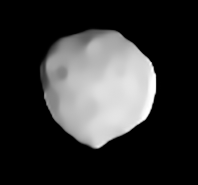
Bamberga is one of the largest asteroids in the asteroid belt. It was discovered by Johann Palisa on 25 February 1892 in Vienna. It is one of the top-20 largest asteroids in the asteroid belt. Apart from the near-Earth asteroid Eros, it was the last asteroid which is ever easily visible with binoculars to be discovered.

(612911) 2004 XR190, nicknamed Buffy, is a trans-Neptunian object, classified as both a scattered disc object and a detached object, located in the outermost region of the Solar System. It was first observed on 11 December 2004, by astronomers with the Canada–France Ecliptic Plane Survey at the Mauna Kea Observatories, Hawaii, United States. It is the largest known highly inclined (> 45°) object. With a perihelion of 51 AU, it belongs to a small and poorly understood group of very distant objects with moderate eccentricities.
(35671) 1998 SN165 (provisional designation 1998 SN165) is a trans-Neptunian object from the Kuiper belt located in the outermost region of the Solar System. It was discovered on 23 September 1998, by American astronomer Arianna Gleason at the Kitt Peak National Observatory near Tucson, Arizona. The cold classical Kuiper belt object is a dwarf planet candidate, as it measures approximately 400 kilometers (250 miles) in diameter. It has a grey-blue color (BB) and a rotation period of 8.8 hours. As of 2021, it has not been named.
474640 Alicanto (provisional designation 2004 VN112) is a detached extreme trans-Neptunian object. It was discovered on 6 November 2004, by American astronomer Andrew C. Becker at Cerro Tololo Inter-American Observatory in Chile. It never gets closer than 47 AU from the Sun (near the outer edge of the main Kuiper belt) and averages more than 300 AU from the Sun. Its large eccentricity strongly suggests that it was gravitationally scattered onto its current orbit. Because it is, like all detached objects, outside the current gravitational influence of Neptune, how it came to have this orbit cannot yet be explained. It was named after Alicanto, a nocturnal bird in Chilean mythology.
(523639) 2010 RE64 (provisional designation 2010 RE64) is a trans-Neptunian object in the scattered disc located in the outermost region of the Solar System, approximately 570 kilometers (350 miles) in diameter. It was discovered on 11 July 2010 by the Pan-STARRS-1 survey at the Haleakala Observatory, Hawaii, in the United States.
C/1999 F1 (Catalina) is one of the longest known long-period comets. It was discovered on March 23, 1999, by the Catalina Sky Survey. The current perihelion point is outside of the inner Solar System which helps reduce planetary perturbations to this outer Oort cloud object and keep the inbound and outbound orbital periods similar.
C/2001 OG108 (LONEOS) is a Halley-type comet with an orbital period of 48.51 years. It was discovered on 28 July 2001 by the LONEOS telescope at Lowell Observatory. Of the short-period comets with known diameters and perihelion inside the orbit of Earth, C/2001 OG108 is the second largest after Comet Swift–Tuttle.
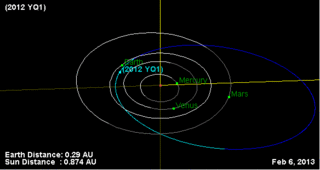
2012 YQ1 is a sub-kilometer asteroid, classified as a near-Earth object and a potentially hazardous asteroid of the Apollo group, approximately 200 meters in diameter. It was first observed on 19 December 2012, by astronomers Andrey Oreshko and Timur Kryachko at the Elena Remote Observatory (G32) located in the Chilean Atacama desert.
(78799) 2002 XW93, provisional designation 2002 XW93, is a trans-Neptunian object and centaur from the outer Solar System, approximately 500–600 kilometers (300–400 mi) in diameter. It was discovered on 10 December 2002, by astronomers at the Palomar Observatory in California.

2014 FC69 is a trans-Neptunian object of the scattered disc on an eccentric orbit in the outermost region of the Solar System. It was first observed on 25 March 2014, by American astronomers Scott Sheppard and Chad Trujillo at the Cerro Tololo Observatory in Chile. It is one of the most distant objects from the Sun, even further away than Sedna.
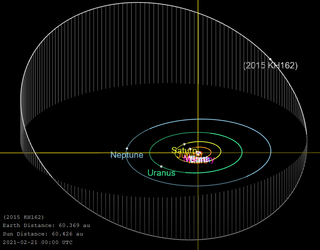
2015 KH162 is a large trans-Neptunian object orbiting in the scattered disc region of the outermost Solar System. First observed in 2015, this minor planet is one of the most distant objects from the Sun at 60.6 AU, or twice as far as Neptune.

2014 FE72 is a trans-Neptunian object first observed on 26 March 2014, at Cerro Tololo Inter-American Observatory in La Serena, Chile. It is a possible dwarf planet, a member of the scattered disc, whose orbit extends into the inner Oort cloud. Discovered by Scott Sheppard and Chad Trujillo, the object's existence was revealed on 29 August 2016. Both the orbital period and aphelion distance of this object are well constrained. 2014 FE72 had the largest barycentric aphelion until 2018. However, the heliocentric aphelion of 2014 FE72 is second among trans-Neptunian objects (after the damocloid 2017 MB7). As of 2023, it is about 66 AU (9.9 billion km) from the Sun.

2014 UZ224 is a trans-Neptunian object and possible dwarf planet orbiting in the scattered disc of the outermost Solar System. As of 2021, it is approximately 89.7 AU (13.42 billion km) from the Sun, and will slowly decrease in distance until it reaches its perihelion of 38 AU in 2142. The discoverers have nicknamed it "DeeDee" for "Distant Dwarf".
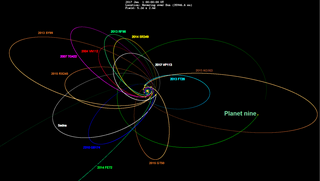
2015 KG163, also known as o5m52, is a trans-Neptunian object from the outermost region of the Solar System, approximately 102 kilometers (63 miles) in diameter. It was first observed on 24 May 2015, by astronomers of the Outer Solar System Origins Survey using the Canada–France–Hawaii Telescope at Mauna Kea Observatories, Hawaii, United States. With an observation arc of 2 years, it passed perihelion around August 2022 at a velocity of 6.5 km/s with respect to the Sun.
(543354) 2014 AN55 (provisional designation 2014 AN55) is a trans-Neptunian object in the scattered disc, located in the outermost region of the Solar System, that measures approximately 600 kilometres (370 mi) in diameter. It was discovered on 25 January 2014, by astronomers with the Pan-STARRS survey at Haleakala Observatory on the island of Maui, Hawaii, in the United States.
2010 GZ60 was originally estimated by JPL to be a near-Earth asteroid approximately 2 kilometers (1.2 miles) in diameter. But is now known to be an asteroid from the inner region of the asteroid belt that does not get closer than 1.5 AU (220 million km) to Earth.
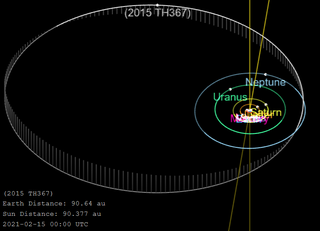
2015 TH367 is a trans-Neptunian object approximately 220 kilometers in diameter. As of 2021 it is approximately 90 AU (13 billion km) from the Sun. At the time of its announcement in March 2018, it was the third most distant observed natural object in the Solar System, after Eris and 2014 UZ224.

2014 SV349 is a large trans-Neptunian object from the scattered disc located in the outermost region of the Solar System. It is one of the most distant objects from the Sun at 60.5 AU. The object is a dwarf planet candidate and measures approximately 423 kilometers (260 miles) in diameter. It was discovered on 19 September 2014, by American astronomer Scott Sheppard at the Cerro Tololo Observatory, Chile, and was provisionally designated 2014 SV349.
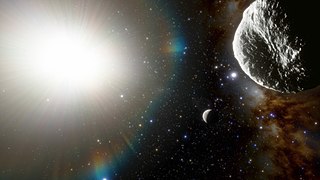
2021 PH27 is a near-Earth asteroid of the Atira group. It was discovered by Scott Sheppard using the Dark Energy Survey's DECam imager at NOIRLab's Cerro Tololo Inter-American Observatory on 13 August 2021. 2021 PH27 has the smallest semi-major axis and shortest orbital period among all known asteroids as of 2021, with a velocity at perihelion of 106 km/s (240,000 mph). It also has the largest value of the relativistic perihelion shift, 1.6 times that of Mercury. With an absolute magnitude of 17.7, the asteroid is estimated to be larger than 1 kilometer (0.6 miles) in diameter.
References
- ↑ "Small-Body Database Lookup". ssd.jpl.nasa.gov. Retrieved 2021-10-01.
- ↑ "JPL Small-Body Database browser". NASA/JPL. Archived from the original on 2021-09-22. Retrieved 2012-03-19.
- ↑ "Solar System Objects at JPL Solar System Dynamics". Archived from the original on 2021-09-19. Retrieved 2021-09-27.